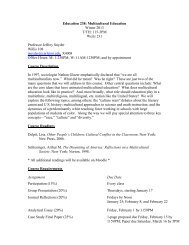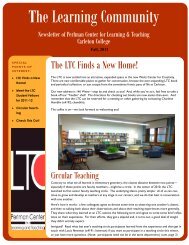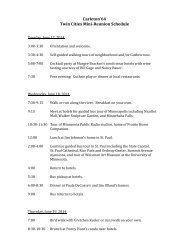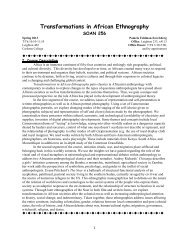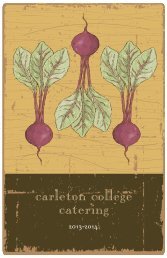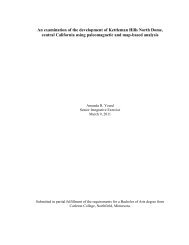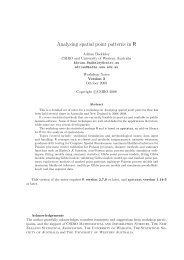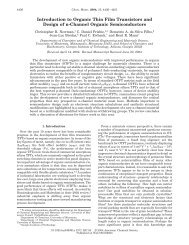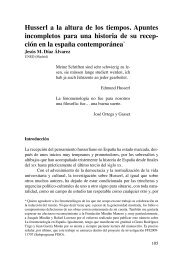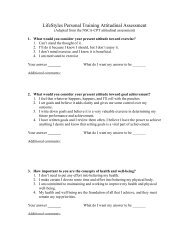Designing EcoHouse. - Carleton College
Designing EcoHouse. - Carleton College
Designing EcoHouse. - Carleton College
You also want an ePaper? Increase the reach of your titles
YUMPU automatically turns print PDFs into web optimized ePapers that Google loves.
<strong>Designing</strong><br />
<strong>EcoHouse</strong><br />
HEATHER BEAL<br />
Feature<br />
56 ARCHITECTURE MINNESOTA<br />
WWhat happens when you gather college students from a broad array of<br />
A cross-disciplinary design course at <strong>Carleton</strong> <strong>College</strong><br />
examines global issues in a campus context<br />
BY HEATHER BEAL<br />
academic disciplines; equip them with pencils, sketchpads, reference<br />
materials, computers, and a building laboratory; then ask them to de-<br />
sign a beautiful, comfortable campus residence that “pushes the para-<br />
digm of eco-efficient living,” all in 10 weeks?<br />
Ask Richard Strong, facilities director at <strong>Carleton</strong> <strong>College</strong> in Northfield,<br />
Minnesota, and Gary Wagenbach, director of <strong>Carleton</strong>’s Environmental<br />
Technology Studies program, who co-<br />
teach a cross-disciplinary class for liber-<br />
al-arts students that fits this description.<br />
Titled “Design and Construction of Eco-<br />
House,” the course attempts to bring<br />
high-level, theoretical discussions on top-<br />
ics such as global warming and energy<br />
policy down to a personal level, where<br />
students can relate their individual life<br />
choices to broader environmental issues.
HEATHER BEAL<br />
Above left: Instructors Richard Strong (shown) and Gary Wagenbach mix conventional classroom lectures with open and animated<br />
discussions to address issues that have “few prescribed solutions.” Above right: Students use “overlaying” to combine their individual<br />
research results and narrow site options for <strong>EcoHouse</strong>. Opposite: Noted green architect William McDonough, FAIA, joined <strong>EcoHouse</strong><br />
students for an informal discussion over breakfast in April 2004.<br />
<strong>Carleton</strong> officials first considered constructing an ecologically<br />
efficient student residence in 2002 after the college<br />
received a capital donation for this purpose. A short<br />
time later, a group of students completed an independent-study<br />
project that examined sustainable campus living.<br />
“Their project raised new questions,” Strong says.<br />
“Would college students want to live in an ecologically efficient<br />
house? What does sustainable mean? To find answers<br />
to these questions, we thought, ‘Why not design<br />
this house ourselves?’”<br />
After writing a preliminary course description,<br />
Strong invited other faculty members to consider<br />
collaborating with him. Wagenbach needed no cajoling.<br />
It made perfect sense for an architect (Strong)<br />
and a biologist (Wagenbach) to co-teach a course<br />
aimed at integrating the built and natural environments.<br />
However, as they soon learned, completing<br />
detailed plans for the <strong>EcoHouse</strong> class, which they<br />
envisioned teaching for up to five consecutive<br />
spring quarters, presented a number of challenges.<br />
A Tin-Foil Blanket<br />
At first students resist the idea of sustainable<br />
living,” Strong says. “Some think they’ll<br />
have to live in a cave with a candle. Others<br />
think they’ll have to shrink the size of their living<br />
space.” Strong and Wagenbach address these<br />
concerns by encouraging students to first think<br />
about how much space, daylight, heating, cooling,<br />
power, and other amenities they would need to<br />
make a home comfortable; then they ask the students<br />
to focus on achieving these goals sustainably.<br />
“Beauty and abundance are found in nature,”<br />
Strong assures them, “and thus are guiding principles<br />
for the design of <strong>EcoHouse</strong>.”<br />
Different teaching styles posed another challenge<br />
for the two instructors, who had never before<br />
collaborated. Wagenbach uses an empirical<br />
method, while Strong relies heavily on intuition.<br />
With a laugh, Strong recalls how Wagenbach once<br />
“wrapped a student in tin foil”—at least that’s<br />
what it looked like—to explore the concept of heat<br />
It made perfect sense for an architect (Strong) and<br />
a biologist (Wagenbach) to co-teach a course aimed at integrating<br />
the built and natural environments.<br />
HEATHER BEAL<br />
NOVEMBER – DECEMBER 2005 57
HEATHER BEAL<br />
Above: <strong>EcoHouse</strong> will likely be constructed in the open area of a thickly foliaged site (upper-right quarter of photo), providing<br />
residents with a wide-open view of a campus lake and island to the south. Opposite: Jeff Lin (left), who portrayed an indentured<br />
servant in the PBS series Colonial House, spoke to students about his sustainable-living experience and later helped construct a<br />
cordwood wall in the building lab.<br />
exchange. In actuality, Wagenbach bundled the<br />
student in a space blanket, taped down the edges,<br />
then asked for periodic reports on how the young<br />
man was feeling.<br />
“He warmed up very quickly,” Strong says. “Yet<br />
intuitively this made no sense because the thin<br />
space blanket doesn’t provide much insulation value.”<br />
Wagenbach explained that the blanket was reflecting<br />
long-wave energy created by the student’s<br />
body. The class also observed that the heat-production<br />
cycle escalated because the student<br />
couldn’t cool himself. “If we had let this go on too<br />
long, we would have had to douse his mitochondria<br />
with cyanide to stop the heat production,” Wagenbach<br />
jokes. “Of course, that would have been fatal.”<br />
“Luckily, we didn’t have to go that far,” adds<br />
Strong, wryly.<br />
58 ARCHITECTURE MINNESOTA<br />
Through experimentation, an essential element in<br />
both the scientific and artistic processes, the instructors<br />
have grown comfortable learning from<br />
each other and from their students. “Gary and I noticed<br />
that we dialogued more in class during the<br />
second year,” Strong says. This classroom dynamic<br />
instills a sense that “there are few prescribed solutions”<br />
for designing sustainably; as a result, students<br />
are more willing to voice their ideas and opinions.<br />
During a lecture about wind roses (diagrams illustrating<br />
wind patterns across a site), for example, a<br />
student asked, “What makes the wind blow?” Strong<br />
answered that variations in low- and high-pressure<br />
gradients cause air to flow between them. A geology<br />
major then spoke up, explaining how the combination<br />
of the earth’s rotation and topographical features<br />
such as plateaus and mountains generates wind.
“Since the class is open to freshmen through seniors from<br />
all disciplines,” Wagenbach says, “we have to respond to the mix<br />
of students who walk through the door.”<br />
Charting a New Course<br />
While the diversity of students enriches the<br />
creative experience, it also complicates the<br />
planning process for a course taught incrementally<br />
over several years. “Since the class is open<br />
to freshmen through seniors from all disciplines,” Wagenbach<br />
says, “we have to respond to the mix of students<br />
who walk through the door.” Thus the instructors<br />
have tried to achieve a “structured openness” by<br />
blending conventional classroom lectures with guestspeaker<br />
presentations, field trips, computer exercises,<br />
and hands-on construction activities.<br />
The required-reading list includes books and web<br />
sites on topics ranging from biomimicry, permaculture,<br />
and regenerative design to the history of the<br />
American home, current housing and lifestyle trends,<br />
and the values and practices of indigenous peoples.<br />
Guest speakers have included architects and engineers<br />
specializing in sustainable design, such as<br />
Rick Carter, AIA, of LHB; John Carmody, director of<br />
the University of Minnesota’s Center for Sustainable<br />
Building Research; and David Eijadi, AIA, and Jay<br />
Johnson, AIA, from The Weidt Group; as well as<br />
people with sustainable-living experience, such as<br />
Jeff Lin, who lived off the land while portraying an indentured<br />
servant in the PBS series Colonial House,<br />
and Allan Stanowitz, who built his own cordwood<br />
house in La Crescent, Minnesota. In 2004, the students<br />
had breakfast with William McDonough, FAIA,<br />
noted green architect and coauthor of Cradle to Cradle:<br />
Remaking the Way We Make Things (2002).<br />
While each segment of the <strong>EcoHouse</strong> course addresses<br />
aesthetics, energy use, life-cycle costs, and<br />
the relationship between a building and its site,<br />
community, and culture, the course “themes” and<br />
two-thirds of the course content vary from year to<br />
year. The inaugural class (2004) focused on answering<br />
the question: “What is natural for Northfield,<br />
Minnesota?” Students researched the history of the<br />
HEATHER BEAL<br />
region and reviewed case studies on housing types<br />
“native” to North America. Then they experimented<br />
with indigenous materials and construction techniques<br />
by building and testing three types of natural<br />
wall systems: straw bale, rammed earth, and cordwood.<br />
They concluded that the straw-bale system<br />
was best because it offered the highest insulation<br />
value for the lowest energy costs.<br />
The students also used the overlaying approach<br />
detailed in Ian McHarg’s Design with Nature (1969)—<br />
transparencies, each addressing a specific parameter,<br />
are placed on the site plan so that unsuitable<br />
building locations are obscured and the most desirable<br />
is highlighted—to systematically analyze seven<br />
possible sites for <strong>EcoHouse</strong>. Four were subsequently<br />
recommended. As the first term progressed, however,<br />
the instructors became “subliminally aware” that,<br />
even after completing rigorous site analyses, the students<br />
seemed “disconnected from the land.”<br />
NOVEMBER – DECEMBER 2005 59
GARY WAGENBACH<br />
Year Two<br />
In 2005, the instructors narrowed the focus of the<br />
course by selecting one site from the four finalists<br />
and prescribing straw-bale walls for three sides of<br />
a student-built test structure. “We hoped this approach<br />
would enable students to gather greater detail<br />
about the unique characteristics of a single site<br />
and, in turn, design a home that captured and employed<br />
the site’s natural energy flows,” says Strong.<br />
To catalyze a debate on the relationship between<br />
the built and natural environments, the instructors<br />
showed the 2005 class a photo of a five-bedroom<br />
house that had recently been constructed near Northfield.<br />
The house sat on a five-acre lawn and most of<br />
its windows faced north. “We asked if there were any<br />
environmental issues we should be concerned about<br />
with this house,” Strong says. The two assumed that<br />
students would identify at least a few of the issues—<br />
for example, the lack of solar orientation—but the students<br />
didn’t think anything needed to be changed.<br />
60 ARCHITECTURE MINNESOTA<br />
“We were shocked,” Wagenbach says. Notes<br />
Strong: “We found that the students could relate to<br />
a structure and its characteristics but not its connection<br />
to the land,” adding that, on further reflection,<br />
he and Wagenbach shouldn’t have been surprised<br />
by the students’ response, since “most people<br />
in Western countries view achievement of human<br />
comfort as disconnected from their surroundings.”<br />
To deepen the students’ understanding of environmental<br />
issues, the instructors divided the class<br />
into four teams and had the teams research renewable<br />
energy sources and technologies while documenting<br />
in greater detail the natural characteristics<br />
of the <strong>EcoHouse</strong> site. The students then used this<br />
combined information to design a south wall for the<br />
test structure that optimizes solar gain and achieves<br />
a desired level of natural lighting. While all four<br />
teams were required to use translucent polycarbonate<br />
and insulated foam panels on the south wall,<br />
“You can only learn so much by thinking about a project,”<br />
says one student. “The real education takes place when you<br />
actually build it and have to solve problems.”<br />
GARY WAGENBACH
they were free to incorporate thermal massing, light<br />
shelves, sun shading, and other eco-efficient strategies<br />
into their final designs. In the end, the students<br />
concluded that passive-solar design strategies<br />
would need to be supplemented by an additional<br />
heat source to maintain year-round interior comfort.<br />
A Positive Influence<br />
In spring 2006, students will design a “living machine”<br />
and explore ways to minimize waste that<br />
flows into, through, and out of <strong>EcoHouse</strong> while<br />
dealing with any waste created in a sustainable<br />
manner. Although the instructors may still be pondering<br />
how best to attune students to nature, there<br />
is little doubt that the <strong>EcoHouse</strong> endeavor is taking<br />
hold. For example, research leading up to and resulting<br />
from the course is now spilling into future<br />
<strong>Carleton</strong> building projects, such as a 40-unit student<br />
residence designed by LHB that will break ground in<br />
fall 2006. “We’ve proposed incorporating some living-machine<br />
ideas into this building’s design, such<br />
as separating gray and black water from storm-water<br />
drainage systems,” Strong says.<br />
The course has also spawned related classes,<br />
including one taught by Wagenbach that explored<br />
how to feed the future residents of <strong>EcoHouse</strong> in a<br />
sustainable manner, and independent-study projects,<br />
such as the construction of a small section of<br />
green roof atop a campus science building and an<br />
economic analysis of investing in wind power. “You<br />
can only learn so much by thinking about a project,”<br />
says Jason Lord, one of two former Eco-<br />
House students who led the green-roof project.<br />
“The real education takes place when you actually<br />
build it and have to solve problems.”<br />
Strong and Wagenbach attribute the high level of<br />
interest in <strong>EcoHouse</strong> to the fact that designing a<br />
home is an ideal way to engage students in the discourse<br />
about sustainability. Sociology major Josh<br />
Tolkan, who took the 2004 course and served as a<br />
teaching assistant the following spring, concurs:<br />
“The class provides a practical way to take environmental<br />
action, because it aims to improve the quality<br />
and efficiency of life.”<br />
“Of course,” Wagenbach adds, “building a tepee<br />
and leaving it in a prominent campus location as<br />
part of our exploration of indigenous dwellings has<br />
helped raise awareness, too. Whenever there’s a<br />
teachable moment, we take it.”<br />
JASON LORD AND DAVE HOLMAN<br />
JASON LORD AND DAVE HOLMAN<br />
Opposite: 2005 <strong>EcoHouse</strong> students used translucent polycarbonate<br />
and insulated foam panels to construct the south wall of a test<br />
structure. This page, top: Students from the 2004 class later designed<br />
and installed a green roof on a canopy overlooking the loading dock<br />
of a campus building. The students first tested plant materials by<br />
growing them in wooden boxes (bottom).<br />
NOVEMBER – DECEMBER 2005 61



